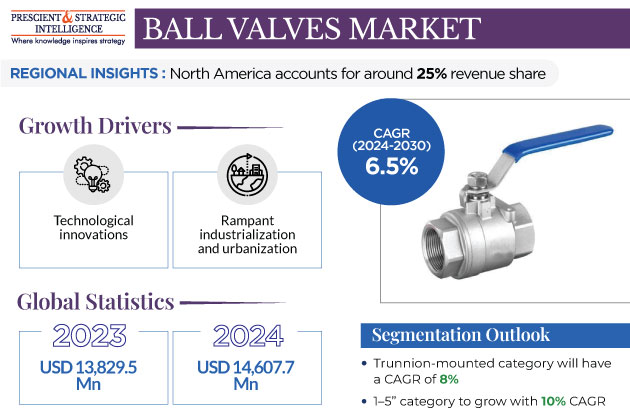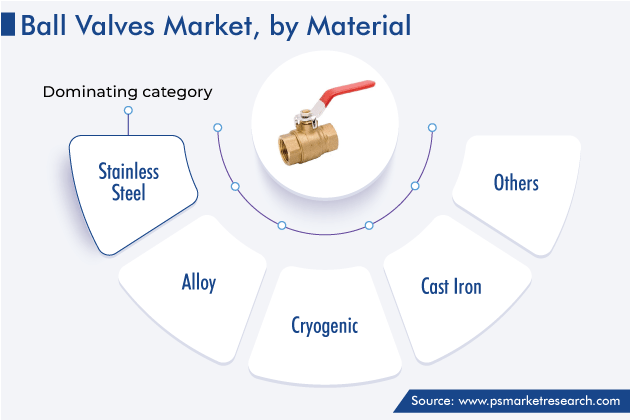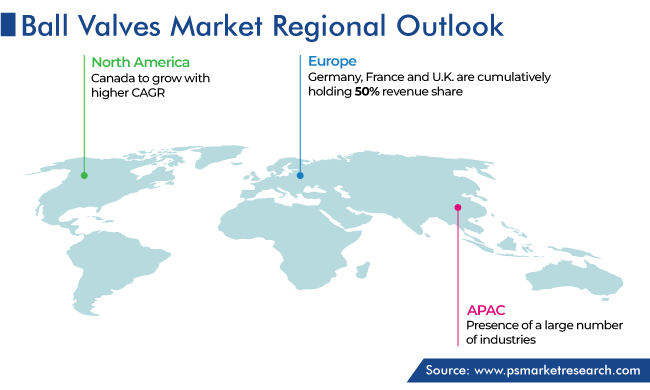Report Code: 12905 | Available Format: PDF | Pages: 230
Ball Valves Market Size and Share Analysis by Material (Cast Iron, Stainless Steel, Alloy, Cryogenic), Type (Trunnion Mounted, Floating, Rising-Stem), Size in Inches (<1,1-5,6-24,25-50,>50), Industry (Oil and Gas, Energy and Power, Water and Wastewater Treatment, Chemicals, Pharmaceuticals, Building and Construction, Food and Beverages, Metals and Mining, Pulp and Paper, Agriculture) - Global Industry Revenue Estimation and Demand Forecast to 2030
- Report Code: 12905
- Available Format: PDF
- Pages: 230
- Report Description
- Table of Contents
- Market Segmentation
- Request Free Sample
Ball Valves Market Outlook
The ball valves market generated revenue of USD 13,829.5 million in 2023, which is expected to witness a CAGR of 6.5% during 2024–2030, reaching USD 21,329.1 million by 2030. This is associated with industrialization, urbanization, infrastructure growth, and rising demand from industries such as oil & gas, water & wastewater treatment, chemicals, and pharmaceuticals. Further, the increasing usage of the 3D printing technology in valve manufacturing and digital transformation are the key trends in the market.

Rampant Industrialization and Urbanization Are Driving Market
The growth of the population and urbanization have led to quick improvements in the industrial infrastructure. Because of the combination of suitable innovations and the knowledge to govern them, several cities can respond to energy, transportation, medical care, and education needs, and natural disasters rapidly and precisely, while upgrading community inclusion, resilience, and sustainability.
- Cities are starting to evolve municipal operations, from transportation to infrastructure repair.
- The ball valves market will profit from the growing focus on the expansion of numerous industries, including water & wastewater treatment, chemicals, oil & gas, and energy & power.
For example, the U.S. has a vast network of old pipelines for moving critical commodities, including oil, water, natural gas, and wastewater. Ball valves have outlived their useful life in the older infrastructure. Thus, such old components are being replaced for improved performance and better laborer safety.
- Moreover, end users are adopting highly reliable, integrated, and cutting-edge solutions to enable better maintenance.
- Over the past four decades, ball valves have become critical in process industries.
- These valves witness significant wear and tear at half their useful life.
- Consequently, the older ones are being substituted with new and improved ones that meet the requirements for material, size, and others for basic applications.
Industries managing hazardous materials, such as oils, gases, petrochemicals, and synthetic compounds, are governed by stringent safety regulations. Ball valves, being crucial in controlling the flow of these substances, need to comply with these safety standards to prevent leaks and accidents and ensure operational safety. Regulations often aim to enhance operational efficiency by ensuring that the equipment used in industrial processes meets certain performance standards. Ball valves that offer higher efficiency, precise control, and reduced maintenance requirements align better with these regulations, thus encouraging their adoption.
- Environmental concerns are a significant factor behind the implementation of regulatory standards on industries.
- Ball valves must meet specific criteria to minimize emissions, prevent leaks, and reduce the environmental impact of the manufacturing process.
- These strict regulations for operational safety and environmental conservation drive the utilization of high-quality valves that fulfill particular standards.
Stainless Steel Variants Hold Largest Market Share
Based on material, the stainless steel category held the largest share, of 45%, in 2023. Because of its strength and superior resistance to corrosion, stainless steel is well-suited for applications involving corrosive liquids and gases. This property is significant for industries such as chemical processing, oil & gas, and water treatment, where resistance to corrosion is paramount. They can endure high pressures, extreme temperatures, and harsh working conditions, thus making them a favored choice in demanding industrial environments.
- A typical 1-inch brass ball valve has a pressure rating of 600 psi, while a standard stainless steel ball valve of the same size will have a pressure rating of 1,000 psi.
- This unique characteristic makes those made of stainless steel specifically suitable for high-pressure applications in the food processing industry.
Stainless steel of different grades and properties allows for customization for particular application requirements. The grades vary in strength and resistance to high temperatures and corrosion, which is why ball valves made from it can be used from extreme cold to high-temperature settings, both indoors and outdoors.
- Due to its compliance with numerous safety and quality standards, stainless steel is frequently chosen over other materials in industries with stringent regulations on the materials used in critical applications.
- In industries such as food and beverage, pharmaceuticals, and health care, where hygiene is critical, stainless steel ball valves are given priority due to their non-reactive and easy-clean surfaces, which reduces the risk of contamination.

Trunnion-Mounted Category Is Rapidly Growing
Based on type, the trunnion-mounted category will have a CAGR of 8% from 2024 to 2030. These variants are characterized by extra mechanical protection to the ball at the top and the base to the valve body, which increases their stability. This design is utilized to manage higher pressures and greater sizes in demanding conditions, where drifting ball valves are not as efficient. These valves are ideal for high-pressure applications in the oil & gas, power, and petrochemical industries. Further, the trunnion-mounted design enables effective sealing, thus reducing the risk of leaks under high-pressure conditions.
- These alternatives also offer less wear and tear on seats and seals.
- They are also popular because of their reliability and long service life.
- These valves are also available in many sizes, pressure classes, and configurations, which offers flexibility in applications where bigger sizes or higher pressures are required.
- Their design makes these valves perfect for automation and remote-controlled systems, which aligns with the increasing level of automation in industrial processes.
- Trunnion-mounted ball valves often meet stringent industry standards for safety, performance, and reliability, which makes them a preferred choice in industries prone to accidents and environmental contamination.
1–5 Inches Category Is Witnessing Highest CAGR
Based on size, the 1–5 inches category is expected to display the highest CAGR, of 10%, from 2024 to 2030. Valves this size find extensive use in water treatment, oil & gas plants, chemical handling, air conditioning frameworks, and other applications. The interest in these components is propelled by the increasing scale of these applications and their requirement for reliable control of liquid and gas streams in moderate-sized pipelines and systems.
Moreover, the construction of residential complexes and commercial buildings often involves the laying of pipelines, plumbing frameworks, and air conditioning networks that require 1–5-inch ball valves. The aging infrastructure and the requirement for substituting or replacing older valves further add to the demand for valves in this size category.
- Industries and municipalities often upgrade their systems to improve reliability, efficiency, and compliance with modern guidelines.
- Valves of this size range are considered standard, which makes them promptly accessible and, in turn, widely used across different businesses.
- The continuous advancements in these components have led to the emergence of more-effective and durable products inside this size range.
- Improved designs, materials, and performance characteristics make them tractive for different applications.
| Report Attribute | Details |
Market Size in 2023 |
USD 13,829.5 Million |
Market Size in 2024 |
USD 14,607.7 Million |
Revenue Forecast in 2030 |
USD 21,329.1 Million |
Growth Rate |
6.5% CAGR |
Historical Years |
2017-2023 |
Forecast Years |
2024-2030 |
Report Scope |
Market Trends, Drivers, and Restraints; Revenue Estimation and Forecast; Segmentation Analysis; Impact of COVID-19; Companies’ Strategic Developments; Market Share Analysis of Key Players; Company Profiling |
Segments Covered |
By Material; By Type; By Size; By Industry; By Region |
Explore more about this report - Request free sample
North America Holds Significant Share Market
North America held the second-largest share, of 25%, in 2023. This is due to the ongoing construction of smart cities, which is driving the usage of advanced ball valves controllable remotely and connected to the internet. This region is also home to major players, who are increasingly focusing on research and development to improve the quality and functionality of their products.

APAC Region Is Set To Have High CAGR
The APAC region is set to have a CAGR of 12% from 2024 to 2030.
- Their strength, high quality, and wide functionality make them popular across key areas, such as oil & gas, water treatment, and manufacturing.
- The rampant infrastructure development and urbanization in the region are directly responsible for this increasing adoption.
- This has further encouraged the market players to engage in R&D to cater better to the changing demands of end users.
APAC nations, including China, India, Japan, and Southeast Asian countries, are rapidly developing various industrial and commercial sectors. The rapid urbanization and infrastructure expansion here drive the interest in ball valves for use in pipelines, water supply frameworks, construction, and other applications. Oil refineries, power plants, and natural gas infrastructure are all being built as a result of the rising demand for energy, particularly in emerging economies.
- Among all of the countries in the market, China is the leader.
Competitive Analysis
The ball valves market is witnessing serious rivalry among participants, who are engaged in extensive product development for a competitive advantage. In order to introduce novel ball valve designs that offer superior performance, efficiency, and durability in various industries, businesses are investing heavily in research and development. Further, mergers, acquisitions, partnerships, and coordinated efforts are helping in product development, distribution network expansion, and market reach enhancement.
Price competitiveness is a crucial factor that impacts the market situation. Manufacturers are attempting to balance pricing with quality, to meet diverse customer needs. In addition, a strong emphasis on aftersales services, technical support, and customization boosts customer satisfaction and brand loyalty. In emerging economies, geographical expansion and market penetration are the essential factors shaping competition. Adjusting products to the changing industry guidelines, sustainability standards, and advancing technologies is also key.
Recent Developments
- In August 2023, KITZ Corporation modified its valve manufacturing business in South Korea by integrating its sales offices and manufacturing facilities.
- In March 2023, Flowserve Corporation introduced the Worcester 51 and 52 series of reduced-port-flanged ball valves.
- In November 2022, KITZ released a new extension to expand the ball valve series.
- In April 2022, Flowserve Corporation signed an agreement with Norway's government to supply its Flowtop and Mark One Control valves for a carbon capture project.
- In April 2022, Valmet Oyj merged with Neles Corporation for Valmet to expand its portfolio for worldwide process sectors.
Top Providers of Ball Valves Are:
- Emerson Electric Co.
- Flowserve Corporation
- KITZ Corporation
- Trillium Flow Technologies
- SLB
- International Management Institute
- Valmet
- Crane Company
- Spirax Sarco Limited
- Bray International
- Velan Inc.
- Neway Valve
Market Size Breakdown by Segment
This report offers deep insights into the ball valves market, with size estimation for 2017 to 2030, the major drivers, restraints, trends and opportunities, and competitor analysis.
Based on Material
- Cast Iron
- Stainless Steel
- Alloy
- Cryogenic
Based on Type
- Trunnion-Mounted
- Floating
- Rising-Stem
Based on Size (in Inches)
- <1
- 1– 5
- 6–24
- 25–50
- >50
Based on Industry
- Oil and Gas
- Energy and Power
- Water and Wastewater Treatment
- Chemicals
- Pharmaceuticals
- Building and Construction
- Food and Beverages
- Metals and Mining
- Pulp and Paper
- Agriculture
Geographical Analysis
- North America
- U.S.
- Canada
- Europe
- Germany
- U.K.
- France
- Italy
- Spain
- Asia-Pacific
- Japan
- China
- India
- South Korea
- Australia
- Latin America
- Brazil
- Mexico
- Middle East and Africa
- Saudi Arabia
- South Africa
- U.A.E.
The industry for ball valves will reach USD 14,607.7 million in 2024.
The ball valves market value will reach USD 21,329.1 million in 2030.
The APAC market for ball valves will advance at a high CAGR during 2024-2030.
The widespread urbanization and industrialization are the key ball valves industry drivers.
Stainless steel hold the larger ball valves market share.
The ball valves industry is observing intense rivalry among players, who are involved in massive product improvements for a competitive advantage.
Want a report tailored exactly to your business strategy?
Request CustomizationWant an insight-rich discussion with the report author?
Speak to AnalystOur dedication to providing the most-accurate market information has earned us verification by Dun & Bradstreet (D&B). We strive for quality checking of the highest level to enable data-driven decision making for you
Our insights into the minutest levels of the markets, including the latest trends and competitive landscape, give you all the answers you need to take your business to new heights
With 24/7 research support, we ensure that the wheels of your business never stop turning. Don’t let time stand in your way. Get all your queries answered with a simple phone call or email, as and when required
We take a cautious approach to protecting your personal and confidential information. Trust is the strongest bond that connects us and our clients, and trust we build by complying with all international and domestic data protection and privacy laws